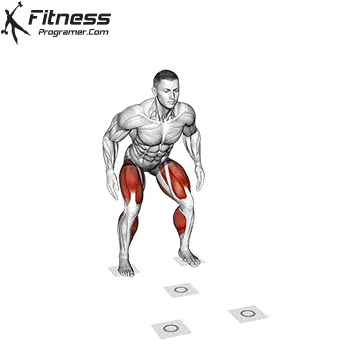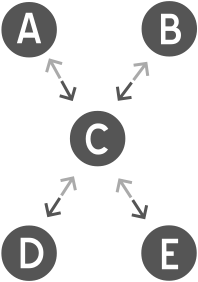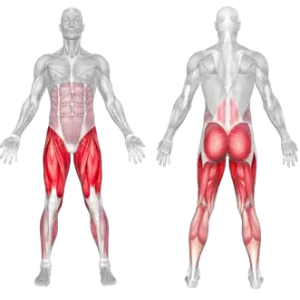Overview
The 5 Dot Drill is an agility workout that involves creating an X-shaped pattern using five markers positioned on the ground. The objective is to perform dynamic jumps and movements between these markers to enhance agility and coordination. Incorporating 5 Dot drills into your training regimen can be a valuable addition for individuals seeking to enhance their athletic performance, agility, and overall fitness.
How to Perform 5 Dot Drill:

1. Setup:
- Arrange five markers on the ground in the sequence A-B-C-D-E to form the layout.
- Stand on the initial markers, A and B.
2. Initial Position (A-B):
- Commence with your feet together on markers A and B.

3. Leap to Point C:
- Swiftly jump forward to marker C, ensuring that your left foot lands precisely on the marker.
4. Leap to D and E (Split Feet):
- Following marker C, perform another explosive jump, but this time separate your feet. Land with one foot on marker D and the other on marker E.
5. Backward Jump:
- Execute a rapid backward jump using both feet, landing on marker C with your left foot.
- Immediately perform another backward jump to return to the starting position, markers A and B, with both feet together.
- Maintain control and balance throughout the entire movement.
6. Repeat:
- Duplicate the sequence, this time leading with your right leg. Strive to execute the drill with maximum speed while adhering to proper form.
8 Benefits of 5 Dot Drill
1- Improved Agility: Agility is the ability to move the body quickly and easily while maintaining control and balance, especially in changing or challenging situations. The 5 Dot Drill is a specialized exercise designed to target and enhance agility through a series of dynamic and multidirectional movements. The dynamic and multidirectional movements required in the drill enhance agility by training the body to change direction quickly and efficiently.
2- Enhanced Coordination: The specific foot placements and dynamic movements required during the drill stimulate the connection between the brain and muscles, fostering improved coordination and neuromuscular control. The intentional and controlled nature of each step fosters a heightened connection between the brain and the muscles involved in the intricate footwork. This process not only sharpens the mind-muscle connection but also refines the intricate coordination skills necessary for diverse physical activities.
3- Increased Speed: The drill encourages participants to execute movements at an accelerated pace, fostering the development of speed and quickness. The incorporation of explosive jumps challenges the muscles to generate force rapidly.
4- Balance Development: Landing on and jumping between markers challenges the body’s balance and stability, activating core muscles and smaller stabilizing muscles in the legs, ankles, and feet. As participants land on one foot and transition between markers, they experience unilateral loading. This uneven distribution of weight challenges the body to stabilize and adapt to changes in load, promoting strength and balance on each leg independently.
5- Sports Performance: Sports are dynamic, and athletes must react quickly to changing situations. Athletes in sports such as basketball, soccer, tennis, and others that require quick lateral movements and changes in direction can benefit significantly from the sport-specific agility and speed developed through the 5 Dot Drill.
6- Cardiovascular Endurance: As a continuous and dynamic exercise, the 5 Dot Drill elevates heart rate and maintains it throughout the session, leading to improved cardiovascular endurance. Cardiovascular endurance is essential for activities that require sustained effort over time, such as prolonged workouts, sports matches, or even everyday tasks that demand continuous physical exertion. The 5 Dot Drill helps individuals build the stamina needed to perform these activities with greater ease and efficiency.
7- Caloric Expenditure: The continuous and rhythmic movements of the 5 Dot Drill result in increased caloric expenditure. This can be beneficial for those looking to manage weight or improve body composition, as it contributes to the overall energy balance by burning calories during the workout.
8- Plyometric Training: Plyometric exercises involve rapid contraction and extension of muscles, utilizing the stretch-shortening cycle. This cycle involves a rapid lengthening (eccentric phase) followed by an immediate shortening (concentric phase) of the muscle. Incorporating plyometric elements such as jumps and explosive movements in 5 Dot Drills contributes to lower-body power and explosiveness.
5 Dot Drill: Muscles Worked
Here are the main muscles worked during the 5 Dot Drill:

- Quadriceps: Located at the front of the thigh, the quadriceps are engaged during the explosive jumps and directional changes of the drill.
- Gluteus Maximus: The largest muscle in the buttocks, the gluteus maximus is involved in generating power during the jumps and providing stability during landings.
- Hip Flexors: These muscles, including the iliopsoas, assist in lifting the legs and driving them upward during the drill’s movements.
- Hamstrings: Situated at the back of the thigh, the hamstrings are engaged during both the explosive jumps and the controlled landings, helping to stabilize the knee joint.
- Soleus: A calf muscle that assists in ankle plantar flexion, the soleus is engaged during the rapid foot movements and jumps of the 5 Dot Drill.
- Gastrocnemius: Another calf muscle, the gastrocnemius works with the soleus to provide strength and stability to the ankle joint during the drill’s movements.
By targeting these muscles, the 5 Dot Drill helps improve lower body strength, power, agility, and coordination, making it a valuable exercise for athletes and individuals looking to enhance their athletic performance.
